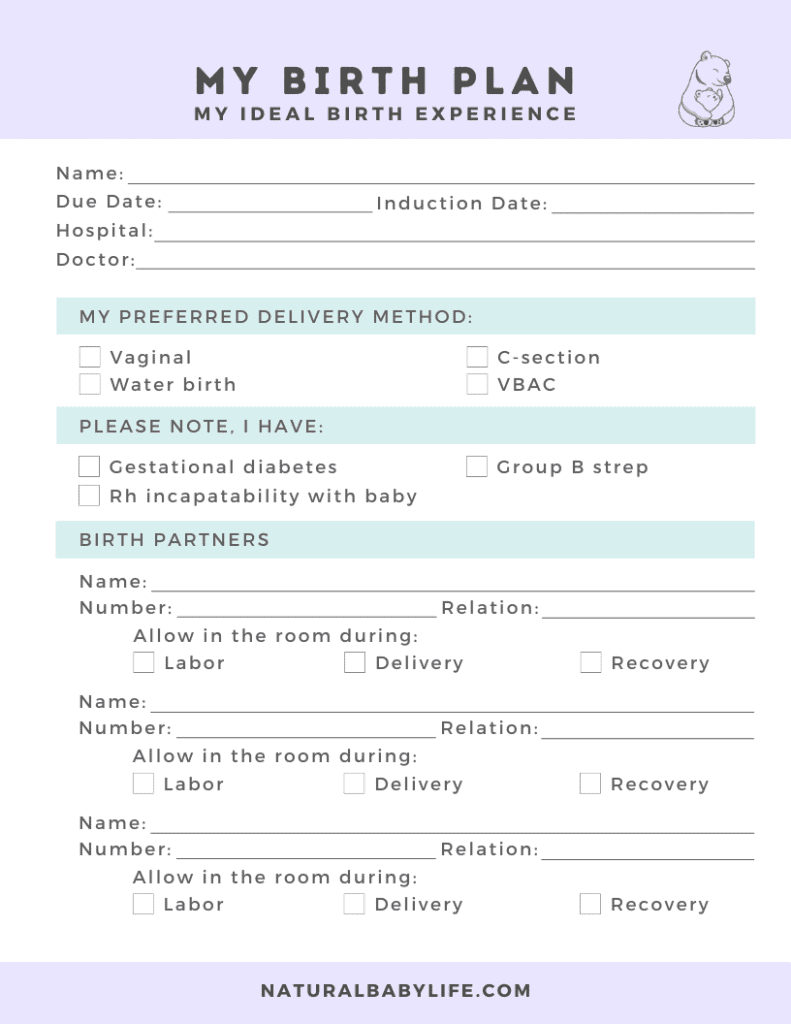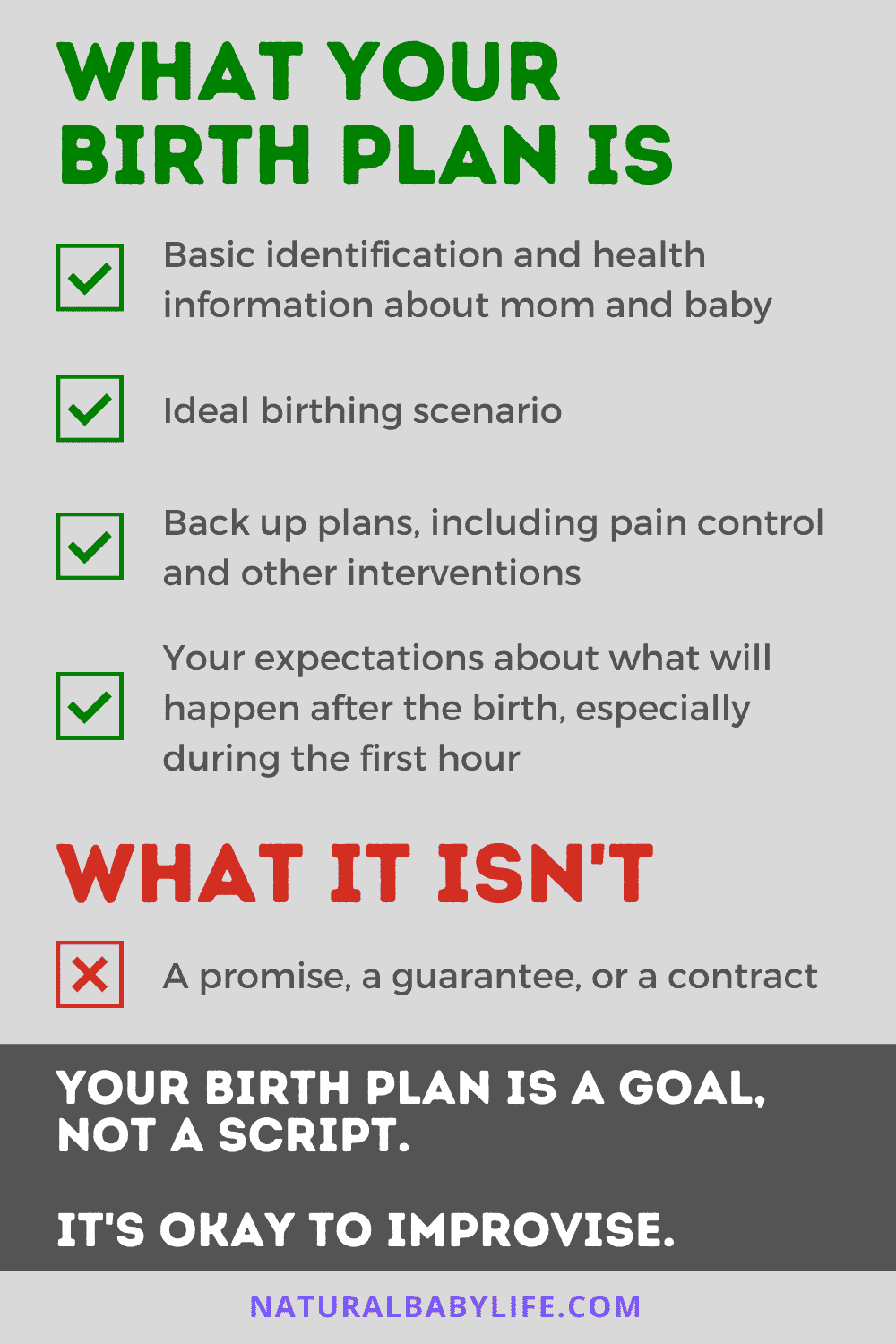Birth plans have somehow become an item of cultural mocking, and this overlooks the importance of a woman’s education and self-advocacy going into one of the most significant medical events of her life.
The purpose of your birth plan is to help you and your partner map out your ideal birth experience and communicate those expectations to your care team at the hospital or birthing center. While there is no guarantee that your birth will go as planned, knowledge and advance planning will help reduce decision-making during this already stressful time.
Keep reading to learn more about the birth plans, how to make them, and what to put in them.
Table of Contents
What is a birth plan?
At its most basic, a birth plan is a woman’s expression of her goals or preferences for birth. They run the range from a few paragraphs – almost like a mission statement – all the way to bulleted, multi-page lists.
The best part? Neither is right or wrong.
Birth plans may be more accurately called birth preferences. Most agree that birth may not go to plan, and the priority will always be a healthy mother and baby. However, respect for the mother’s body and her preferences when safety is not at stake must be equally important.
Birth plans are much more than a piece of paper with ‘rules.’ They give women the opportunity to explore their own values and identify what is important to them in giving birth and their first hours with their new baby. It also opens the door for the mother to discuss these things with her birth partner and establish the birth partner’s role in the room.
Why did birth plans become popular?
The earliest known suggestion to make a birth plan stems from 1980. Since that first suggestion more than four decades ago, birth plans have firmly ingrained themselves in American birthing culture.
This change reflects many of the changes in our society as women become equal participants in the economy and society. Women now have the opportunity to educate themselves regarding birth, and the medical practices have improved to a point that we can focus on the elements of the birth rather than just the outcome.
Most importantly, we as a culture now recognize the autonomy of women’s bodies and that they are active participants in the birthing process. To understand why this was a novel concept 40 years ago, and to some extent, today, it is important to know common birthing practices in our mothers’ and grandmothers’ times.
A brief and terrible history of birth in the United States
Historically, giving birth was a dangerous business, especially in places that suppressed the education of and treatment by female attendants.
Danger gave way to something else entirely as male physicians replaced informally taught women. Safety improved as more was learned about the dangers of infection and bloodletting.
In the 1860s, pain control was introduced in the form of opium. Then, in the early 1900s, doctors discovered the use of scopolamine. This medication places patients in a semi-conscious state and creates the inability to remember what happened.
Scopolamine, however, did not impact the pain of birth. Women were routinely restrained to beds and left alone to thrash in pain. Friends and family members were not permitted. Newborns were then withheld until the mothers could shake the scopolamine.
This practice, which began in 1915, continued into the 1970s. A Ladies Home Journal exposé in 1958 finally brought the inhumane treatment of birthing mothers into the national spotlight.
The organization that would later become known as Lamaze International was created in response to the twilight birth fallout. The epidural was created in the 1960s.
Birth plans today
Today, birth plans provide a clear way for patients to communicate with their care providers.
By discussing your birth plan long before the big day, you can get a sense of your doctor’s openness to your wishes and attitude toward patient input.
Most importantly, remember that you retain the right to informed consent, especially when you are delivering a child.
Is a birth plan necessary?
Hospitals may ask you to fill out a document where you identify specific preferences, but they aren’t going to make you create a birth plan. So no, they are not mandatory from the hospital’s perspective.
Birth plans can help you identify any fears or concerns you have about what could happen in the labor and delivery room. This way, you have the opportunity to work through those feelings and problem-solve real-world solutions before being in the heat of the moment when it could be very hard to think.
A birth plan may feel absolutely necessary, especially for women who have experienced trauma, previous complicated births or have experienced baby or child loss or infertility.
By discussing your birth plan with your birth partner, you can enlist them to help you advocate for yourself so that you can share the weight of that burden.
How to write a birth plan
Remember your audience when crafting your birth plan:
- You
- Your birth partner
- Your nursing staff
- Your doctor(s)

Because each segment of your audience has a different need from your birth plan, it may actually have several iterations.
Some options for actually writing your plan include writing it from scratch, using a template, or completing any preference paperwork that your hospital or doctor may provide. The internet is a great resource for birth plan templates. They are highly customizable, but many cater to specific types of births or concerns going into the birth. Not only do they create a framework, but they can also generate ideas for you to address.
Here is a printable birth plan template!
Do’s and don’ts of writing a birth plan
It can be daunting to start a birth plan. Use this combination of do’s and don’ts to help you get started.
When making a birth plan, DO:
- Make it easy to read. Keep in mind that nurses usually see multiple laboring mothers in one day.
- Keep in mind that emergencies happen. Do not become so married to the idea of a specific chain of events that you feel out of control if you have to deviate from your preferences.
- Remember that nurses and doctors cannot read your mind. If you have a significant concern, be sure to share it.
- Research your hospital’s policies to know whether you are asking for things within their policies or specifically prohibited.
- Educate yourself on every component of your birth plan and make informed decisions.
- Share a little about yourself to help staff be invested in your care. Is this a rainbow baby? Are you scared to do this without your mother? Let them know where you are coming from.
When making a birth plan, DO NOT:
- Use hostile language or tone to get off on the wrong foot with care providers.
- Make it hard or lengthy to read.
- Rely on only one avenue or type of birth. Address the most common contingencies in the plan.
When should you write a birth plan?
When making your birth plan, do it early enough that you can take action to enact it, if needed.
Ideally, slowly make your birth plan over time as you learn more about your pregnancy, delivery, and the first hours after birth. Your birth plan is a living document that you can change at any time.
When you wait until the last minute to make it, you do lose the opportunity to discuss it with your doctor during birth. Or, perhaps worse, it doesn’t give you enough time to find a new doctor if you find out your doctor is not supportive or even open to something you consider a dealbreaker.
Be sure that the hospital you plan to use is a good fit for your birth plan. For example, if you include nitrous oxide in your birth plan, be sure that the hospital actually offers it!
What to include in a birth plan
When creating your birth plan, approach it from the three stages of before, during, and after delivery.
Besides helping you walk through the big day, it also helps your care provider hone in on the important parts as you progress through labor and birth.
Birth plans for first-time moms
First-time moms face a unique pressure to plan for something they have yet to experience. The fear of the unknown looms as you’re told to go to birth classes and read books. Stories of medical horrors and births gone awry don’t instill confidence going into birth.
Birth plans can be especially helpful for first-time mothers to identify their fears and concerns and seek information from doctors or other reliable sources.
Doulas are great resources no matter how many children you have had but are especially helpful for first-time mothers feeling anxious about navigating labor and delivery.
Before delivery
The early part of your birth plan covers the beginning stages of labor before you go to the hospital and when you are first admitted.
This part of the birth plan may be more relevant to you and your birth partner than to hospital staff.
One of the most important things in this part of the plan is identifying who will be in the room with you. If you have any concerns about an unwelcome visitor, be sure to notify the hospital when you check in.
During delivery
Delivery constitutes the real bulk of most birth plans. This is a scary phase of the process as you transition to the hospital and put yourself in the hands of people you don’t know.
Fortunately, your birth plan helps those care providers know you and your wishes. Here are some things you may want them to know about you:
- Whether you have any pertinent health concerns like gestational diabetes, high blood pressure, Group B strep, umbilical cord issues, or any other concerns about you or your baby’s health and success during delivery.
- If you prefer a saline lock rather than immediately starting fluids.
- Your intentions regarding pain management.
- Any delivery positions, procedures, or touching that you do not consent to.
- Any comfort measures you want to be implemented by staff or your partner.
- Whether you want to be consulted before any non-emergent medications are administered (e.g. Pitocin)
- Who you want in the room at the time of delivery.
- Whether you consent to students observing any part of your labor and delivery.
- Whether you have any particular privacy or modesty concerns.
After delivery
Addressing in advance your preferences for your newborn’s care takes the pressure off you and can help you enjoy those first minutes and hours with your new baby.
Most women address the golden hour in their birth plan. Let the care providers know what your wishes are for this first, special hour with your newborn.
Here are some common items:
- Skin-to-skin contact – Identify whether you want the baby to be placed directly on your chest after birth. Hospitals with the ‘baby friendly’ designation usually have this in their default procedures after birth.
- Cord clamping – Indicate whether you want the baby’s umbilical cord to be clamped immediately or after it stops pulsing.
- Feeding method – Make it clear whether you intend to bottle or breastfeed in your birth plan so that you don’t need to take your attention from your baby to explain.
Your plan can also address what happens after the golden hour and throughout your stay:
- Hospitals may need to know in advance if you want a 24-hour discharge instead of the usual 48-hour discharge.
- Make it clear if you are not comfortable with the baby being taken out of the room without a parent.
- Clarify whether you permit the usage of a pacifier.
You may not need to include any of these things in your birth plan, depending on your specific hospital. Many hospitals automatically implement the golden hour methods, emphasize rooming-in, and withhold the pacifier until breastfeeding is established.
These are all great topics to discuss with your doctor or ask about during your hospital tour.
How to make sure the hospital follows the birth plan

To give your birth plan the best shot at success, make it easy to read and understand. Keep it brief and make use of color or symbols to draw the eye to critical points.
Be proactive about discussing your birth plan with your doctor throughout your pregnancy. When you are admitted to the hospital for
delivery, remind them of your birth plan and have copies with you. You or your partner may need to do this several times as shifts change and you see new nurses and doctors.
Unfortunately, there is no guarantee that a particular doctor or nurse will respect your wishes, no matter how reasonable, simple, and clear. Obstetric conflict remains a real concern in the United States.
Your birth partner will be key to ensuring your birth plan is respected. While no hospital can guarantee an unmedicated, uncomplicated vaginal birth, they can ensure that you are not coerced into an epidural, shamed into unnecessary procedures, or treated with disrespect.
- Your birth partner needs to feel comfortable reminding providers of your birth preferences.
- If your partner is unwilling or unable to assume this role, consider hiring a doula to assist you during birth. While a doula cannot make decisions for you, she can educate you regarding your options and the consequences and support you in your self-advocacy.
Prior to birth, ask your doctor’s opinion on informed consent. Their answer and resulting conversation can help you determine whether their professional values are in line with your needs. Additionally, you and your partner should be aware of your legal rights concerning birth.
How do I choose which hospital to give birth in?
Depending on your location, even having a choice can feel like a luxury. For those who do have more than one hospital within a reasonable distance, try to take a tour of any that you are considering.
Come to the tours armed with questions that you may have:
- Do they allow student doctors in the room?
- What is the triage process, and how long does it take?
- Does it have a religious affiliation, and if so, how may that impact your care?
- What equipment does it have to assist in unmedicated labor?
- Does it have a baby nursery?
- Does it facilitate the golden hour?
Can you have a natural birth in a hospital?
One of the many items to address in your birth plan is whether you want a medicated birth, and if so, what type and how much. You can indicate in your plan that you do not want an epidural.
Be sure to determine what pain-coping sources your hospital does offer. Some hospitals are fully equipped for patients forgoing an epidural and offer jetted birthing tubs, birth balls, birth stools, aromatherapy, and even nurses specially trained in unmedicated births.










